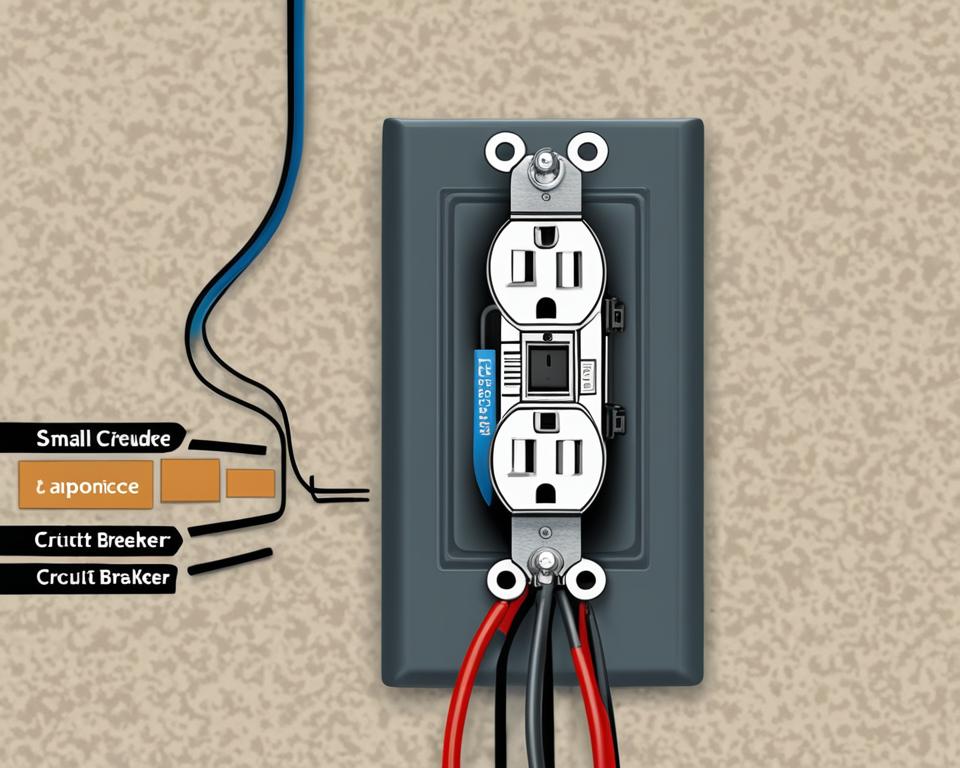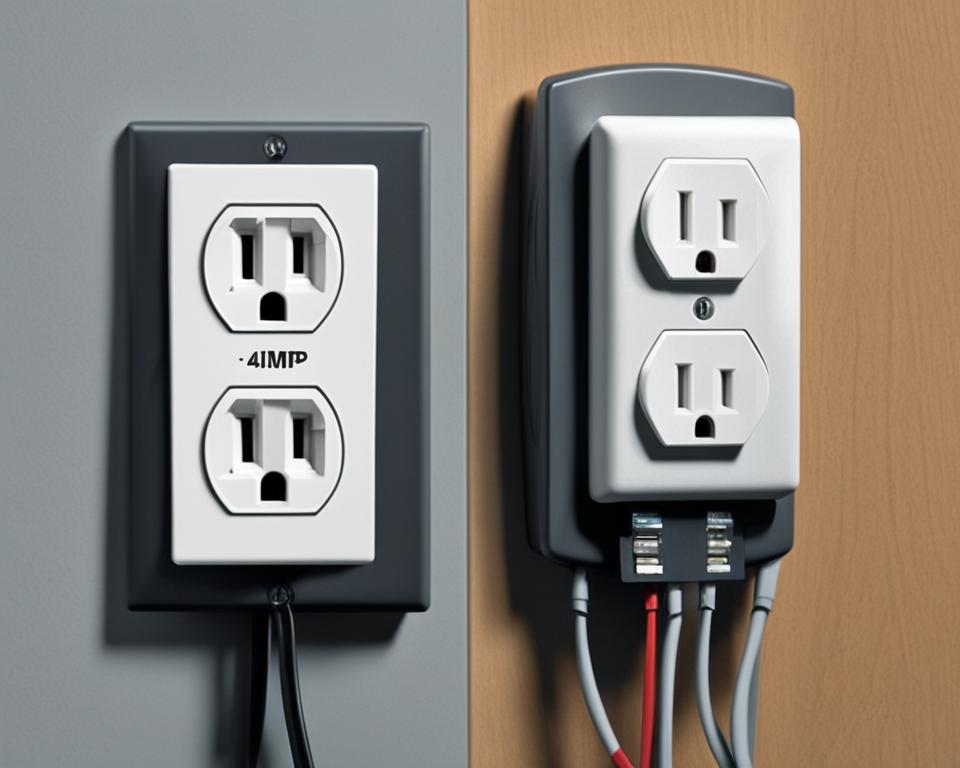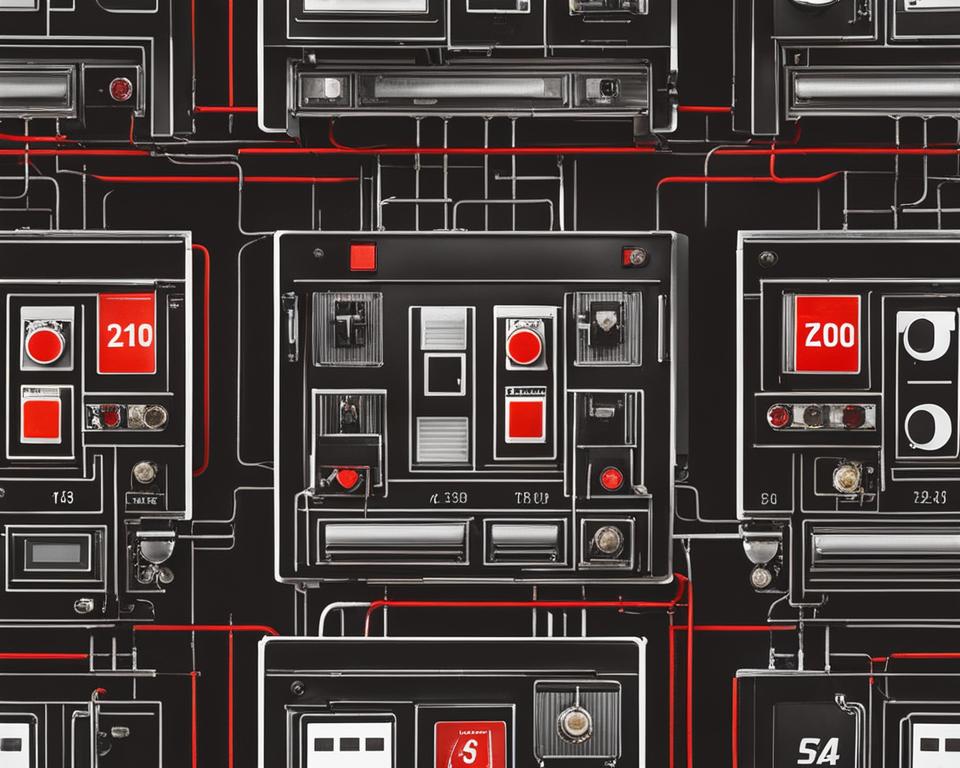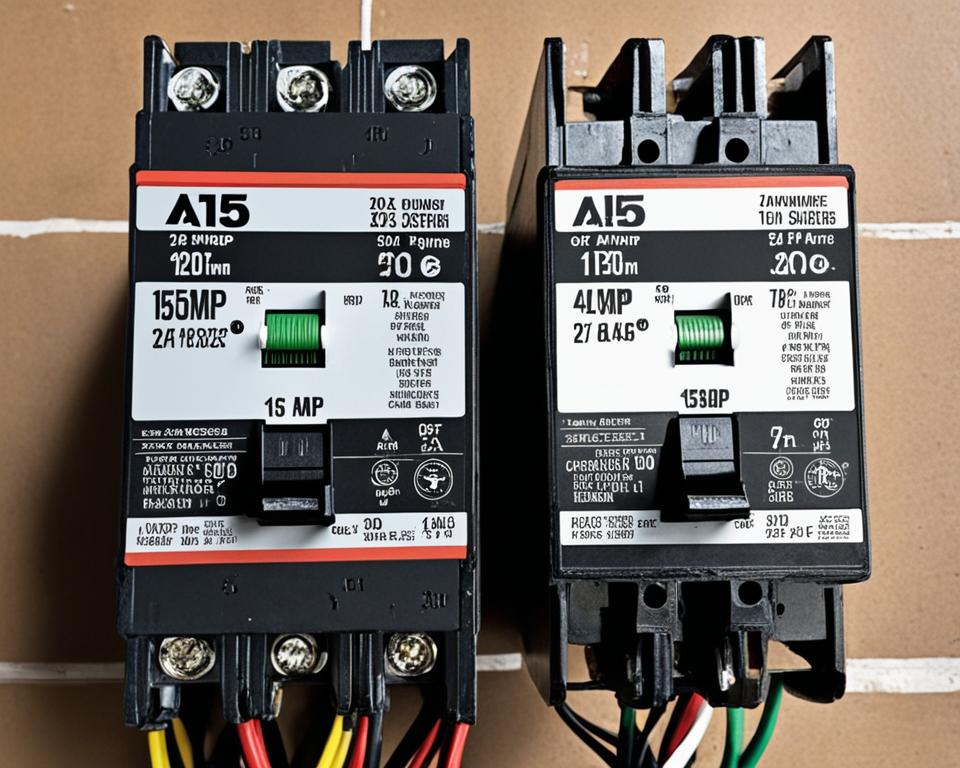When it comes to choosing between a 15 amp breaker and a 20 amp breaker, it’s important to understand their differences and consider the specific electrical needs of your home. Circuit breakers play a crucial role in protecting your electrical system from overloading and potential hazards. By selecting the appropriate circuit breaker size and rating, you can ensure the safety and efficiency of your home’s electrical wiring.
Key Takeaways:
- Determining the right amp breaker depends on understanding your home’s electrical needs and the type of appliances you plan to use.
- A 15 amp breaker is suitable for general light fixtures and smaller electrical devices with lower power requirements.
- A 20 amp breaker is ideal for areas like the kitchen, bathroom, and garage where high-power appliances are commonly used.
- Matching the right receptacles to the appropriate amperage is essential for safety and functionality.
- Consulting a professional electrician can help you determine the best circuit protection for your home.
Understanding the 15 Amp Breaker
A 15 amp breaker is designed to carry the electrical load from small electrical devices such as lights and alarm clocks. According to the National Electric Code (NEC), a 15 amp breaker can carry a total capacity of 1,800 watts, but it is recommended to only use 80% of its capacity. This means that the permissible load is around 1,400 watts or 12 amps.
It is also important to note that a 15 amp circuit requires a 14-gauge cable for proper wiring. Therefore, a 15 amp breaker is suitable for general light fixtures and smaller electrical items that have lower power requirements.

| Electrical Load | Permissible Load (Watts) | Recommended Wiring (Gauge) |
|---|---|---|
| Light fixtures | Up to 1,400 | 14-gauge |
| Alarm clocks | Up to 1,400 | 14-gauge |
When using a 15 amp breaker, it’s important to consider the electrical load to prevent overloading the circuit. Ensure that the total wattage of the connected devices does not exceed the permissible load. Additionally, using a 14-gauge cable for wiring will ensure efficient and safe electrical flow.
Exploring the 20 Amp Breaker
When it comes to handling larger electrical currents, the 20 amp breaker is the ideal choice. Unlike its counterpart, the 15 amp breaker, the 20 amp breaker is capable of carrying a higher capacity of electricity without being overloaded. This is due, in part, to its utilization of a thicker 12-gauge wire for wiring purposes. The 12-gauge wire provides a stronger and more efficient electrical connection.
The 20 amp breaker is particularly well-suited for areas in the home where high-power appliances are commonly used. Let’s take a closer look at these areas:
- Kitchen: The kitchen is a hub of activity with appliances such as stoves, ovens, and refrigerators consuming significant amounts of electricity. Connecting these appliances to a 20 amp breaker ensures a stable power supply and prevents electrical overload.
- Laundry Room: Washing machines and dryers are high-power appliances commonly found in the laundry room. To handle the electrical demand of these appliances, a 20 amp breaker is necessary.
- Bathroom: Electric showers, hair dryers, and other bathroom fixtures often require a higher electrical capacity. Installing a 20 amp breaker in the bathroom ensures reliable power for these devices.
- Garage: Power tools, electric vehicle chargers, and other garage equipment can put a strain on the electrical system. Using a 20 amp breaker in the garage can handle the increased power demand.
- Dining Room: A dining room may feature appliances like wine coolers or mini-fridges that require more power. By connecting these devices to a 20 amp breaker, you can avoid electrical issues and potential power outages.
It’s important to keep in mind that high-power appliances draw more electricity and can overload a 15 amp circuit, leading to tripped breakers and power disruptions. By utilizing a 20 amp breaker and the appropriate wiring, you can ensure a stable and uninterrupted power supply, even when using multiple high-power appliances simultaneously.
Determining Your Home’s Amperage
To determine the amperage of your home, there are a few methods you can follow. First, you can inspect your electrical panel and check the labels for each circuit. The labeling on the electrical panel will indicate the amperage number associated with a specific circuit. For example, if your bedroom is labeled as circuit No. 12 with a 15 amp switch, it means that you need to purchase receptacles that match the amperage requirement.
If you’re unsure about the amperage ratings of your circuits, it’s important to consult a professional electrician. They can assess your electrical panel and provide accurate information regarding amperage numbers. This ensures that you choose the right receptacles for your home, preventing any electrical hazards or overloads.
| Circuit No. | Amperage Rating | Recommended Receptacles |
|---|---|---|
| 1 | 20 amps | 20 amp receptacles |
| 2 | 15 amps | 15 amp receptacles |
| 3 | 20 amps | 20 amp receptacles |
| 4 | 15 amps | 15 amp receptacles |
Remember, it’s crucial to select receptacles that match the amperage rating of your circuits to ensure safety and compliance with electrical codes.
Matching the Right Receptacles
When it comes to electrical wiring in your home, it’s crucial to choose the right receptacles for safety and functionality. Whether you have a 15 amp circuit or a 20 amp circuit, selecting the appropriate receptacles is essential for efficient power distribution. Let’s explore the different options available.
15 Amp Receptacles
If your circuit is designed for a 15 amp breaker, it is important to use 15 amp receptacles as per the National Electric Code (NEC) guidelines. These receptacles are perfect for powering general light fixtures and smaller electrical devices. From table lamps to alarm clocks, these receptacles can handle the electrical load of everyday household items.
However, it’s crucial not to overload a 15 amp circuit. Adhering to the NEC recommendations to use only 80% of the circuit’s capacity ensures both safety and longevity for the electrical system.
20 Amp Receptacles
If you have a 20 amp circuit, you have a bit more flexibility when it comes to receptacle options. For multiple receptacles on the same circuit, 15 amp receptacles are acceptable. They can handle the power requirements of general lighting and smaller electrical items, similar to what a 15 amp circuit can power.
However, for dedicated circuits that power high-power appliances such as kitchen appliances, a 20 amp receptacle is necessary. These appliances, such as stoves, ovens, and refrigerators, require more robust electrical connections. Using a 20 amp receptacle ensures that the circuit can handle the higher electrical load without risking overload or damage to the wiring system.
Choosing the Right Receptacles
To summarize, matching the right receptacles to your electrical circuit is crucial. Use 15 amp receptacles for 15 amp circuits, ensuring that they are not overloaded and only handling the appropriate electrical load. For 20 amp circuits, employ 15 amp receptacles for multiple receptacles on the same circuit. However, for dedicated circuits that power kitchen appliances and other high-power devices, a 20 amp receptacle is necessary.
Remember, when dealing with electrical wiring and circuits, it’s always best to consult a professional electrician. They can provide expert advice tailored to your home’s specific needs, ensuring proper installation and adherence to safety standards.
| 15 Amp Receptacles | 20 Amp Receptacles |
|---|---|
| Perfect for general light fixtures and smaller electrical devices | Required for dedicated circuits powering kitchen appliances and high-power devices |
| Useful for regular household items like table lamps and alarm clocks | Ensure the circuit can handle the higher electrical load without overload |
| Adhere to NEC recommendations for load, not exceeding 80% of the circuit’s capacity | Provide a robust electrical connection for heavy-duty appliances |
Remember, safety should always be the priority when dealing with electrical systems. Choosing the right receptacles ensures proper functionality and reduces the risk of electrical hazards. If you’re unsure about which receptacles to use or need assistance with any electrical wiring, consult a professional electrician for reliable guidance.

Wiring Considerations
When it comes to electrical systems, it is crucial to understand the capacity and limitations of your home’s wiring. By considering factors such as the electrical system capacity, electrical grid capabilities, receptacle types, and circuit ratings, you can ensure the smooth and safe operation of your electrical circuits and prevent overloading.
In most residential electric grids, the wiring system is designed to handle up to 20 amps. This means that the electrical system can carry a maximum current of 20 amps without overloading. However, it is common to have a few 15 amp receptacles connected to the 20 amp circuit to provide flexibility and convenience for plugging in multiple devices.
By connecting 15 amp receptacles to a 20 amp circuit, you can safely distribute power to various devices without overloading the system. This setup allows you to plug in appliances, electronics, and other electrical devices throughout your home without the risk of tripping circuit breakers.
To further optimize the electrical system capacity, it is important to consider the number of receptacles and circuits needed based on your specific electrical needs. By calculating the power requirements of your devices and assigning them to appropriate circuits, you can ensure that each circuit operates within its safe limits, reducing the risk of overloading.
Understanding Overloading and Its Consequences
Overloading occurs when the total load connected to a circuit exceeds its current-carrying capacity. This can lead to overheating, which poses a serious fire hazard and can damage the electrical system, appliances, and potentially harm individuals in the vicinity.
By properly distributing the electrical load among the circuits and using appropriate receptacles, you can prevent overloading and maintain the safety and efficiency of your home’s electrical system. This includes considering the power requirements of appliances and devices in different areas of your home, such as the kitchen, laundry room, and other high power usage areas.
It’s important to note that different areas of your home may require dedicated circuits with higher amp ratings to accommodate the power demands of specific appliances. For example, a kitchen may require a dedicated 20 amp circuit for high-power appliances like refrigerators and stoves.
To help you manage the electrical load and prevent overloading, here is a table highlighting some common household devices and their approximate power requirements:
| Device | Power Requirement (Watts) |
|---|---|
| Light Bulb | 60 |
| Coffee Maker | 900-1500 |
| Microwave Oven | 800-1500 |
| Toaster | 800-1500 |
| Hair Dryer | 800-1800 |
| Air Conditioner (window unit) | 900-1440 |
| Refrigerator | 150-800 |
| Dishwasher | 1200-2400 |
By using this table as a reference and understanding the power requirements of your devices, you can distribute them across appropriate circuits and receptacles to prevent overloading.

Remember, maintaining the performance and safety of your electrical system requires a balanced approach. Consider the electrical system capacity, power requirements, and correct wiring techniques to avoid overloading and ensure the smooth operation of your home’s electrical grid.
Upgrading to a 20 Amp Breaker
If you have a 15 amp circuit with a 12-gauge wire, it may be tempting to upgrade to a 20 amp breaker for increased electrical capacity. However, it’s crucial to consider the wire size and the potential risks involved. Installing a 20 amp breaker on a 14-gauge wire, which is thinner, can lead to overheating and pose a fire hazard. It’s important to prioritize safety and consult a professional electrician before making any modifications to your electrical system.
When it comes to electrical circuits, wire size plays a critical role in preventing overheating and potential fire hazards. A 14-gauge wire has a smaller diameter compared to a 12-gauge wire, which means it has a lower capacity to carry electrical current. If you try to push more current through a 14-gauge wire than it can handle, it can heat up excessively and pose a significant risk of overheating.
By replacing the 15 amp breaker with a 20 amp breaker, you’re effectively allowing more current to flow through the circuit. If the wire size isn’t compatible with this increased current, it can lead to unsafe conditions. The 14-gauge wire may not be able to dissipate the heat generated by the higher amperage, potentially causing the wire insulation to melt or catch fire.
Always remember, electrical safety should be the top priority when dealing with electrical systems. Before upgrading to a 20 amp breaker, consult a professional electrician to assess your wiring and ensure it is compatible with the increased amperage.
Conclusion
Choosing between a 15 amp breaker and a 20 amp breaker depends on understanding the specific electrical needs of your home. If you have general light fixtures and smaller appliances, a 15 amp breaker will be sufficient. However, if you have high-power appliances in areas like the kitchen or laundry room, a 20 amp breaker is necessary. It is crucial to prioritize circuit protection to prevent overloading and potential hazards.
To ensure the safety and proper functioning of your electrical system, it is always recommended to consult with a local electrician. They can assess your electrical needs, evaluate your wiring, and provide expert guidance on selecting the right breaker size for your home. By consulting an electrician, you can make informed decisions and avoid potential electrical issues in the future.
Remember, circuit protection is essential for maintaining the integrity of your home’s electrical system. Whether you opt for a 15 amp breaker or a 20 amp breaker, it’s crucial to prioritize safety and consult professionals who can help you navigate your electrical needs effectively.
FAQ
What is the difference between a 15 amp breaker and a 20 amp breaker?
A 15 amp breaker is designed for smaller electrical devices and has a total capacity of 1,800 watts, while a 20 amp breaker can carry larger electrical currents and is suitable for high-power appliances.
What is the recommended load for a 15 amp breaker?
It is recommended to use only 80% of the total capacity of a 15 amp breaker, which is around 1,400 watts or 12 amps.
What kind of electrical devices should be connected to a 20 amp breaker?
A 20 amp breaker is ideal for appliances such as heaters, air conditioners, coffee machines, dryers, and other devices that consume significant amounts of electricity.
How can I determine the amperage of my home?
You can inspect your electrical panel and check the labels for each circuit to determine the amperage number associated with a specific circuit.
What type of receptacles should I use for a 15 amp circuit?
For a 15 amp circuit, it is recommended to use 15 amp receptacles, which are suitable for general light fixtures and smaller electrical devices.
Can I use 15 amp receptacles on a 20 amp circuit?
Yes, you can install 15 amp receptacles on a 20 amp circuit if there are multiple receptacles on the same circuit. However, dedicated circuits with a single receptacle for powerful kitchen appliances require a 20 amp receptacle.
How many receptacles can be connected to a 20 amp circuit?
The wiring system in most residential electric grids can handle up to 20 amps, with a few 15 amp receptacles connected to the 20 amp circuit, allowing multiple devices to be plugged in without overloading the system.
Can I replace a 15 amp breaker with a 20 amp breaker?
If the wire size is compatible (12-gauge wire), you can replace a 15 amp breaker with a 20 amp breaker. However, it is recommended to consult a professional electrician before making any modifications to your electrical system.
How do I choose between a 15 amp breaker and a 20 amp breaker for my home?
The choice depends on understanding the specific electrical needs of your home. A 15 amp breaker is sufficient for general light fixtures and smaller appliances, while a 20 amp breaker is necessary for high-power appliances in areas like the kitchen or laundry room. It is always recommended to consult with a local electrician for safety and proper functioning of your electrical system.
